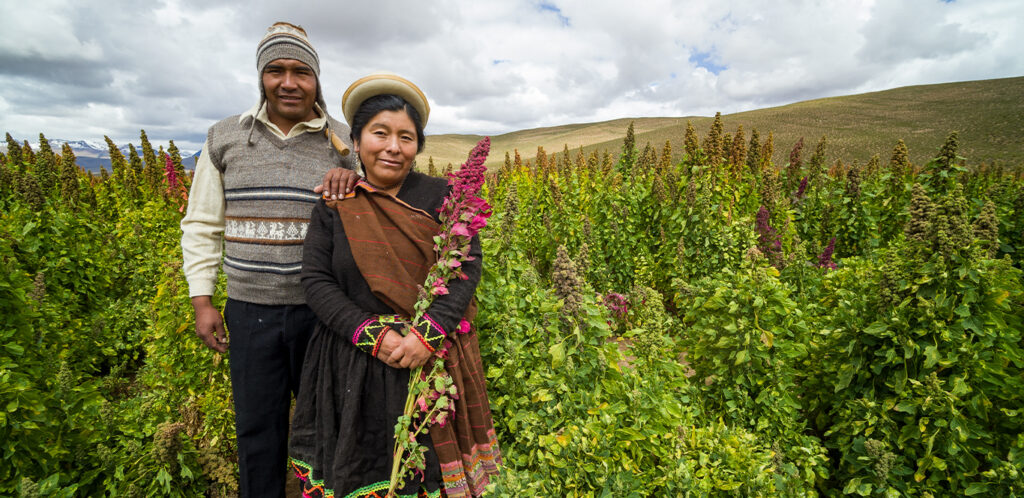
The mother of all grains to the Incas, today a superfood that can help feed the world. Quinoa — “keenwah” — is a broadleaf plant species (chenopodium quinoa) genetically close to sugarbeet and spinach, functionally raised as a grain crop and so sometimes termed a pseudo-cereal.
There are thousands of varieties of quinoa, most of them wild. Most valuable are the heirloom strains nurtured by Bolivian farmers to thrive in saline soils at at high altitude, resisting drought, frost and saline soils to provide the unrivaled goodness of Royal Quinoa.
Quinoa has been growing naturally amid the severe landscape of Bolivia’s altiplano for thousands of years. The plants grow from tiny seeds to as much as six feet in about a hundred days, protected from pests by an outer coating of bitter-tasting saponin and maturing in shades of green, gold and red. Llamas provide natural fertilizer, and half a pound of planted seeds can yield up to 2,000 pounds of new seed per acre at harvest.

The farmers sow, reap and thresh their quinoa by hand before it is traded in local markets, trucked to processing facilities, cleaned to remove the saponin and field debris then shipped to global customers including major food companies and individual consumers.
Harvested quinoa seeds come in a variety of colors, of which three are widely available in retail outlets. White (golden) quinoa, the most commonly found, offers the mildest taste, smoothest texture and shortest cooking time. Red seeds add vibrant color and nutty taste to cold dishes and salads. Black quinoa is favored for its earthy sweetness and crunchy texture. Quinoa is versatile: it is ground into flour for use in flatbreads, pasta and many more baking applications, and it can be found in alcoholic beverages, shampoo and cosmetics. Quinoa leaves can be eaten and taste much like spinach, although typically they are not exported.
Quinoa is nutritionally richer than wheat, barley and other “true grains.” It is a rare, plant-based source of complete protein, boasting all nine essential amino acids. It’s high in fiber, rich in important minerals, totally gluten-free.
The varieties of Royal Quinoa we offer have been grown by smallholder farmers for over 2,000 years in the high Andes mountains. Family farms are located at 12,000 feet of altitude, around the salt flats of Bolivia. Their family plots are small, with 2 to 20 acres. They rely on their herloom seeds, natural rainfall and traditional farming methods. Farmers harvest their quinoa by hand before selling it to Jacha Inti for further cleaning and export.

Our mission is to “share quinoa with the world.” The impact we seek as a company is to improve both the incomes of smallholder Andean farmers and the health of consumers.
Jacha Inti was founded in La Paz- Bolivia in 2008 by U.S., French and Bolivian entrepreneurs. We at Jacha Inti wanted to make it possible for thousands of smallholder farmers to improve their lives by accessing the international markets that demand purity, safety, uniformity at industrial volumes. Together we worked to solve the supply chain issues that kept quinoa from regaining its status as a staple food. Today Jacha Inti is recognized as a leading processor and supplier of organic quinoa to the world. The family is Certified Organic, Gluten-Free, Fair Trade, Regenerative (ROC) and FSSC22000.
ROYAL QUINOA (WHITE, RED, BLACK and TRICOLOR)
“Royal Quinoa” is a single-origin quinoa. It is prized for its size, taste, texture and nutrition.
Available in Organic and Conventional.
Packing: 11.34 kg, 25 kg or 1,000 kg bags
Origin: Southern Altiplano Region of Bolivia. Area surrounding Uyuni Salt Flats. Farmed exclusively by smallholder farmers.
Certification Options: Certified Organic, Fair-Trade Certified (Fair Trade USA, FLO), Regenerative Organic Certified (ROC). Kosher (including Kosher for Passover). Gluten-Free. 100% traceability to farmers on Fair Trade and ROC options
Aspect: Large seed size, homogeneous size grading. Presents well in retail bags.
Specifications: Uniform large size, highest purity >=99.995. 100% testing for pesticide residues and microbial levels
Availability: Widely available in conventional and organic. Limited volumes in Fair-Trade and ROC Certified.
Applications: hot side dishes, bowls, grain blends. Leading choice for premium retail. Cooks uniformily with 1 cup of quinoa to 2 cups of water in 15 minutes covered.

Royal White
Flavor: Slightly nutty, slightly earthy, light herbal note.
Color: Light cream
Texture: Fluffy. Slightly crunchy
Cook TIme: 15 minutes. 1 cup of quinoa to 2 cups of water
Purity: >99.995%
Flavor: Slightly nutty, earthy.
Color: Ranges from reddish brown to red. With some white seeds. Flaky residues of shells visible on a few seeds (these disappear during cooking and do not influence flavor or quality).
Texture: Slightly fluffy, crunchy
Cook TIme: 15 minutes. 1 cup of quinoa to 2 cups of water
Purity: >99.995%
Flavor: Nutty, earthy.
Texture: Crunchy
Color: black, dark burgundy with some red and white seeds. Some flaky shells visible on seeds (these disappear during cooking and do not influence flavor or quality)
Cook Time: 18 minutes. 1 cup of quinoa to 2 cups of water. Will hold up well to extended cooking (soups, baking, etc)

Mail: export.info@delizia.com.bo
Phone: (+1) 240 756 2625 / (+1) 646 639 9710
9001 New Hampshire Ave Suite 10 Silver Springs, MD 20903
